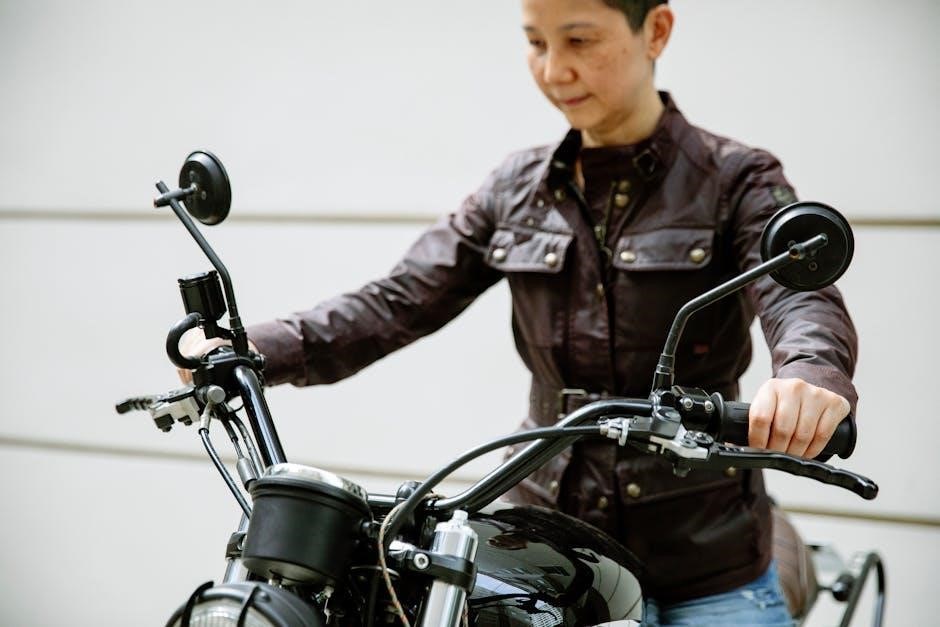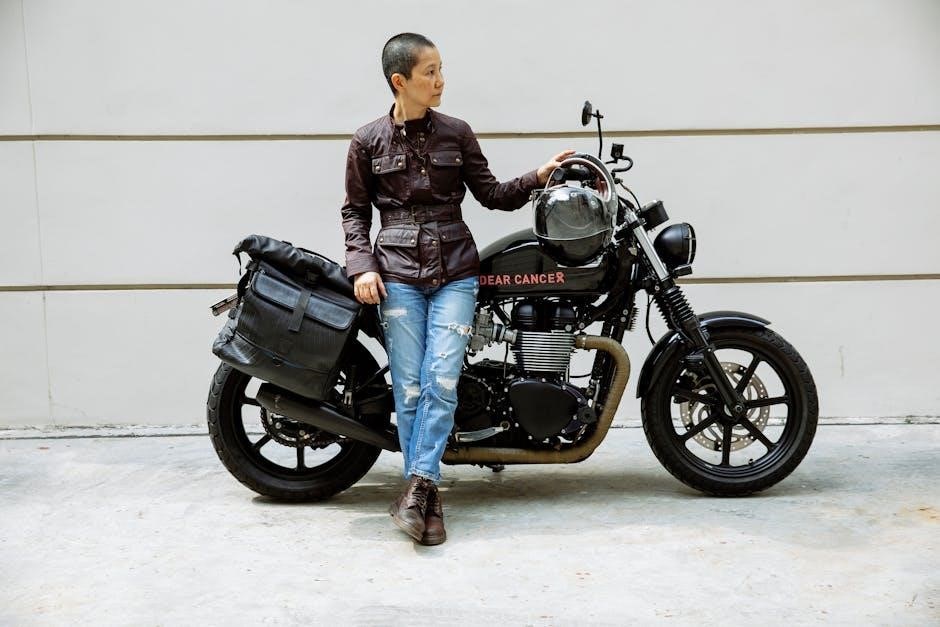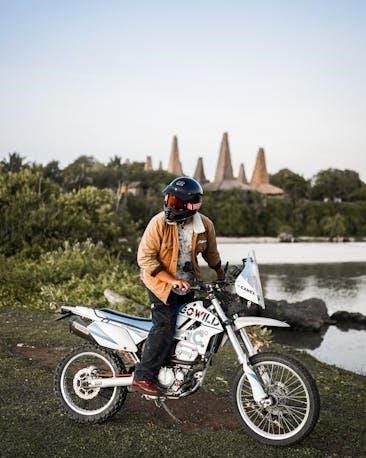A well-fitting motorcycle jacket is essential for safety, comfort, and protection. Ill-fitting jackets can restrict movement or leave gaps, compromising both style and functionality. Proper sizing ensures optimal protection, allowing riders to enjoy their journey without discomfort. Understanding how body type, weight, and riding style influence fit is crucial for selecting the right jacket. This guide will help you navigate size charts and find the perfect fit for your needs.
Why Proper Fit Matters for Safety and Comfort
A proper fit ensures optimal protection and comfort while riding. A jacket that’s too tight may restrict movement, while one that’s too loose can flap in the wind, causing distractions. Ill-fitting jackets can lead to discomfort, fatigue, and reduced focus on the road. Correct sizing ensures armor and padding align with your body, providing maximum protection. A well-fitting jacket enhances mobility, reduces wind fatigue, and keeps you comfortable during long rides, making it a critical choice for both safety and enjoyment.
Overview of the Importance of a Well-Fitting Jacket
A well-fitting motorcycle jacket is crucial for both safety and style. Proper fit ensures that protective features like armor and padding align correctly with your body, maximizing protection in case of impact; It also prevents restrictive movement, allowing for better control of your bike. A jacket that fits well enhances comfort during long rides, reduces wind fatigue, and boosts confidence. Investing in the right size ensures your jacket serves its purpose effectively, combining protection, comfort, and a tailored look for an optimal riding experience.
Understanding Key Measurements for Jacket Sizing
Chest, waist, and sleeve measurements are crucial for accurate sizing. Compare these dimensions with the brand’s size chart to ensure a proper fit and optimal protection.
How to Measure Chest Size Accurately
To measure your chest size, wrap a flexible tape measure around the fullest part of your chest, keeping the tape level and parallel to the floor. Ensure the tape isn’t too tight or too loose for an accurate reading. This measurement is crucial for determining your jacket size, as it directly impacts both comfort and protection. Proper fit ensures optimal safety and style while riding. Always refer to the brand’s size chart for the best results.
Importance of Waist and Sleeve Length Measurements
Waist and sleeve length measurements are vital for a comfortable and functional fit. Your waist size ensures the jacket sits correctly, preventing riding up or restriction. Sleeve length must reach your wrists when arms are slightly bent, allowing full mobility. Accurate measurements prevent discomfort and ensure protective features like armor align properly. Combining chest, waist, and sleeve measurements guarantees a jacket that’s both protective and comfortable, enhancing your riding experience. Always use a size chart for precise fit guidance.

Factors Influencing Jacket Size and Fit
Body type and weight significantly impact jacket fit. Riders with broader chests or slimmer builds may need tailored sizes. Riding style also affects fit, as sport vs. cruiser styles require different measurements. Understanding these factors ensures a jacket that’s both comfortable and protective, enhancing overall riding safety and enjoyment. Accurate sizing considers individual body proportions and riding preferences for optimal fit. Proper measurements guarantee a secure and functional jacket that meets your specific needs. Correct fit enhances safety, comfort, and style during rides. Ensure measurements align with your body and riding style for the best experience.
How Weight and Body Type Affect Sizing
A rider’s weight and body type play a crucial role in determining the ideal jacket size. Individuals with a broader chest or athletic build may require a larger size for comfort, while those with a slimmer frame might prefer a more tailored fit. Weight distribution can also affect how the jacket sits, ensuring it’s neither too tight nor too loose. Proper sizing ensures maximum protection, flexibility, and comfort during rides. Understanding these factors helps in selecting a jacket that aligns with your body structure and riding needs. Accurate fit is essential for both safety and style.
Impact of Riding Style on Jacket Fit
Your riding style significantly influences how your motorcycle jacket should fit. For aggressive or sport riding, a snug fit is crucial for optimal protection and aerodynamics. Conversely, cruiser or touring riders may prefer a slightly looser fit for comfort during long rides. The jacket should allow freedom of movement while maintaining a secure fit to prevent shifting during maneuvers. Ensuring the jacket accommodates your riding posture and movement is key to both safety and comfort. Proper fit adapts to your unique riding needs, enhancing the overall experience.
How to Measure Yourself for a Motorcycle Jacket
Accurate measurements are key to finding the right fit. Measure your chest at its fullest point, natural waist, and sleeve length from shoulder to wrist. Use a flexible tape measure and stand up straight for precise results. Ensure the jacket fits comfortably while allowing freedom of movement. Proper measurement ensures safety and comfort during rides.
Step-by-Step Guide to Taking Body Measurements
Start by measuring your chest at the fullest point, keeping the tape measure level and parallel to the floor. Next, measure your natural waistline, typically around the narrowest point of your torso. For sleeve length, measure from the center back of your neck, over your shoulder, and down to your wrist. Ensure the tape is snug but not tight. Stand upright and avoid slouching for accurate results. These measurements will help you align with the size chart perfectly, ensuring a comfortable and secure fit for your motorcycle jacket.
Once you have your measurements, compare them to the brand’s size chart to find your best match. Pay attention to chest, waist, and sleeve lengths. Note that sizes can vary between brands, so double-check the specific chart for accuracy. If your measurements fall between sizes, consider your preference for a tighter or looser fit. Ensure the jacket aligns with your riding style and body type for optimal comfort and protection. This step ensures a precise fit tailored to your needs.
Comparing Sizes Across Different Brands
Using a Size Chart to Determine Your Fit
Compare your measurements to the brand’s size chart to ensure accuracy. Note that sizes vary between brands, so always check the specific chart provided. Measure your chest, waist, and sleeve length, and match them to the chart. If you’re between sizes, consider your preference for a tighter or looser fit. Ensure the jacket aligns with your riding style and body type for optimal comfort and protection. This step ensures a precise fit tailored to your needs, enhancing both safety and style while riding.
Understanding Variations in Brand Sizing Charts
Different brands often have unique sizing standards, making direct comparisons challenging. Some brands cater to specific body types or riding styles, while others prioritize comfort or protection. Material thickness and armor placement can also affect fit. Always consult the brand’s size chart and read reviews to understand how their sizing runs. Measure yourself accurately and compare to the chart to ensure the best fit. Variations in sizing highlight the importance of thorough research before making a purchase.
How to Choose the Right Size for Your Favorite Brand
To find your ideal jacket size, compare your measurements with the brand’s size chart. Pay attention to chest, waist, and sleeve lengths. Consider your riding style and personal comfort preferences. Read reviews from other customers with similar body types to gauge fit accuracy. If unsure, contact customer support for guidance. Some brands offer fit adjusters to tailor the jacket to your body. Ensuring the right fit enhances both safety and riding enjoyment. Always prioritize comfort and protection when making your choice.

Considering Comfort and Style Preferences
Comfort and style are crucial when choosing a motorcycle jacket. A well-fitting jacket balances protection with flexibility, ensuring ease of movement while riding. Personal preference plays a significant role in deciding between tight or loose fits, impacting both aesthetics and functionality. Always prioritize comfort to enjoy a safe and enjoyable riding experience.
Tight vs. Loose Fit: What’s Best for You
The debate between tight and loose fits depends on your riding style and comfort preferences. A tight fit offers better protection and reduces wind flapping, enhancing aerodynamics. However, it may restrict movement if overly snug. A loose fit provides more comfort and flexibility, ideal for casual rides. Yet, excessively loose jackets can compromise safety and cause distractions. Ultimately, the best fit balances protection, mobility, and personal comfort, ensuring a safe and enjoyable riding experience without sacrificing style or functionality.
Balancing Protection and Flexibility in Your Jacket
A motorcycle jacket must balance protection and flexibility to meet rider needs. Built-in armor enhances safety without compromising mobility, while stretch panels allow ease of movement. Quality materials like leather or durable textiles provide durability. Adjustable features ensure a tailored fit, optimizing both comfort and protection. Prioritizing these elements ensures the jacket performs well during rides, offering peace of mind and versatility for various riding conditions while maintaining a stylish appearance that suits individual preferences and requirements.

How Armor and Padded Areas Affect Fit
Armor and padded areas in motorcycle jackets add bulk, impacting fit. Built-in protectors like CE armor inserts ensure safety but may require sizing adjustments for comfort. Check size charts carefully to accommodate these features while maintaining optimal protection and mobility.
Impact of Built-In Armor on Jacket Sizing
Built-in armor significantly affects motorcycle jacket sizing. Armor inserts, such as CE-certified protectors, add bulk to areas like shoulders, elbows, and the back. This can make the jacket feel tighter or more restrictive. When choosing a size, consider the armor’s thickness and placement. Compare your measurements to the brand’s size chart, ensuring the jacket fits comfortably while accommodating the armor. Proper fit is crucial for both protection and mobility, so don’t compromise on either.
Ensuring Proper Fit with Armored Jackets
Armored jackets require careful sizing to ensure both protection and comfort. Measure your chest, waist, and sleeve length accurately, then compare with the brand’s size chart. Consider the armor’s placement and thickness, as these can affect fit. If between sizes, choose the next size up for comfort. Adjustments like zippers or Velcro can help fine-tune the fit. Always prioritize mobility and coverage; the jacket should feel snug but not restrictive, ensuring safety without hindering movement during rides.

Special Considerations for Men’s and Women’s Jackets
Men’s and women’s jackets differ in fit and design. Women’s jackets often feature tailored shapes to accommodate curves, while men’s styles focus on broader shoulders. Measure accurately to ensure the best fit for your body type, considering chest, waist, and sleeve lengths. Choose styles that align with your riding style for optimal comfort and protection.
Differences in Sizing Between Men’s and Women’s Jackets
Men’s and women’s motorcycle jackets differ in sizing due to body structure variations. Men’s jackets often prioritize chest measurements, while women’s jackets may include waist and hip considerations. Women’s styles typically offer more flexibility in the chest area to accommodate curves, while men’s jackets focus on broader shoulders and torso length. Proper fit for both requires accurate measurements, ensuring comfort, mobility, and protection. Always refer to brand-specific size charts for the best fit.
How to Choose the Best Fit for Your Body Type
Choosing the best fit for your body type involves considering your height, weight, and proportions. For taller riders, ensure sleeves and torso length are adequate. Broader shoulders may require a slightly larger size, while slimmer builds can opt for a tailored fit. Petite riders should look for jackets with adjustable features to avoid excess material. Always compare your measurements to the brand’s size chart and prioritize comfort for optimal protection and mobility.
Addressing Common Sizing Challenges
Common challenges include being between sizes or inconsistent sizing across brands. Use detailed size charts and consider adjustable features to ensure a tailored fit for comfort and protection.
What to Do If You’re Between Sizes
If you find yourself between sizes, compare your measurements with the brand’s size chart and consider adjustable features like sleeves or waist straps. Opting for the larger size often ensures better mobility and comfort, especially if you plan to wear layers or armor underneath. Prioritize fit based on your riding style—tighter for sport bikes, looser for casual cruising. Consult customer reviews or reach out to the brand for guidance to make the best choice.
How to Handle Inconsistent Sizing Across Brands
Different brands often have varying fit standards, so comparing your measurements to each brand’s size chart is crucial. If one brand runs small, the next might run large. Measure yourself accurately and cross-reference with the specific chart. Consider reading reviews from others with similar body types to gauge fit. If unsure, opt for a size that accommodates your chest and waist, as these are key areas for comfort and mobility. Adjustable features like sleeves or waist straps can also help customize the fit.
A well-fitting jacket ensures safety and comfort. Use size charts, consider your riding style, and prioritize protection. Find your perfect fit today for an enhanced riding experience.
Summarizing the Key Points for a Perfect Fit
Proper fit is crucial for safety, comfort, and mobility. Measure chest, waist, and sleeve length accurately, and refer to brand-specific size charts. Consider your body type, weight, and riding style to ensure the jacket aligns with your needs. Prioritize comfort while maintaining protection, as tight or loose fits can compromise functionality.
Try the jacket while sitting to ensure flexibility and check for gaps or restrictions.
Balancing protection and style ensures a safe, enjoyable riding experience.
Encouraging Readers to Take Action and Find Their Ideal Jacket
Now that you’ve gathered the knowledge, it’s time to act! Use the size charts and measurement tips to find your perfect fit. Prioritize both style and protection. Visit a store to try on jackets or order online with confidence. Remember, a well-fitting jacket enhances your riding experience. Don’t compromise on safety or comfort—take the next step and find the jacket that’s made for you. Happy shopping and safe riding!
